

 | ||
 | ||
Vol. 12 (1): June 2009 | ||
Croatia / Greece / Italy / Mauritania & Western Sahara / Spain / Turkey
Italy
| |||||||||||||||
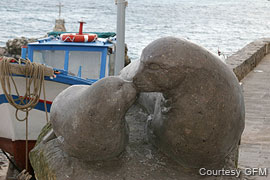 | |
Recently, Marco Di Salvo, a young man frequenting Marettimo with his family for many years, with a fondness for marine conservation and monk seals, had the idea of recalling their memory through a monument, to be erected at the small island harbour. It would serve as a remembrance for local inhabitants and tourists of the seals’ former presence in Marettimo waters and caves, and evoke the promise of a possible return.
Marco, however, died tragically less than a year ago. His father Franco and his mother Karmen did not want Marco’s dream to vanish, and so with support of our association, Gruppo Foca Monaca (GFM), and of Emanuele Coppola in particular, we persuaded the sculptor Giulio Cosimi Bagnada, to help realise Marco’s dream by carving a statue depicting a mother and pup.
The statue was carved from a typical stone of the region north of Rome, the “basaltina” (from basalt). Once completed, it was brought to the island and erected at the harbour, with a special ceremony on the morning of 19 April involving the whole community of Marettimo, including the fishermen, and the local Egadi islands’ political and religious authorities. Preceded, the evening before, by the screening of a Panda Film movie on Mediterranean monk seals and by a public debate, the event was supported by different local associations, and even – thanks to Mr. De Salvo’s relations – by prominent figures like M. Nicolas Sarkozy and Claudia Cardinale, as well as scientists and researchers (such as Giuseppe Notarbartolo di Sciara, Teresa Pastor, Aliki Panou and Ali Gücü), who sent messages of support either in writing, or in audio or video-conference form, aired during the inauguration.
Recalling the presence of this shy and vulnerable marine mammal, the sculpture intends to represent an appeal for environmental respect and protection, a conscience for the weak and helpless among us, and a symbol of peace among people living around the shores of the Mediterranean. A smaller copy of the statue has also been made and will soon be sent in a twinning with the Marine Sanctuary of Monterey (California, USA), where a sizeable community of people from the islands once settled, having emigrated from Marettimo.
But Franco Di Salvo wants to go even further in realising his son’s dream: his idea, shared by the local authorities and inhabitants, is to prepare additional scaled-down copies of the statue to be donated to other important seal landmarks in the Mediterranean, creating new trans-boundary friendship ties.
Furthermore, with the help of GFM, Franco would like to create in Marettimo a centre where monk seal conservationists could meet and create the foundations for improved seal conservation activities in the Mediterranean. A first meeting, on the attitudes of humans versus monk seals and their environment, could already be convened before the end of this year.
More information will be provided through the GFM web site or can be requested by writing to . – Luigi Guarrera, GFM.
Following the success of its earlier guided tours, GFM is again organising an expedition to the Mediterranean coast of Turkey and the Levant Nature Conservation Society’s monk seal project this summer (19-28 June) and autumn (23 October - 1 November).
The trips are organised by GFM through Panda Avventure, the WWF Italy group organizing nature holidays. The travel programme, costs and related details are available for download. [Cilician Programme 2009  120 KB]
120 KB]
Observations of monk seals using open beaches has increased dramatically since the creation of the ‘Coast of the Seals’ marine-terrestrial reserve in 2001 in Mauritania – a possible turning point in the recovery of the species in the Atlantic.
Apart from groups and individuals staging a return to such open beaches, a pup nursing from its mother was also filmed by CBD-Habitat technicians in October 2008 [see report and video, Lactation on an open beach in Cabo Blanco, TMG 11 (2): November 2008] – the first observation of its kind in 60 years.
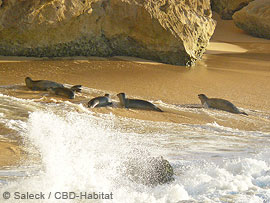 | 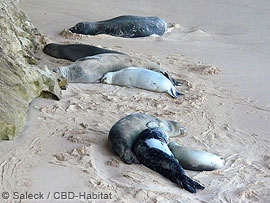 | |
|
| ||
Recent observations indicate another surge in numbers of seals occupying the area’s open beaches. “Until last year,” explains Pablo Fernández de Larrinoa of CBD-Habitat, “they were individuals or small groups of 3-4 animals. This year we have been observing groups of up to 9 animals!”
The CBD-Habitat team working at Cabo Blanco has been observing, almost every day, large groups of monk seals hauling out in the breeding caves during low tide. Thanks to the remote-control video cameras installed in the caves, we have been witness to spectacular images of these animals, which we can now share with the public. – Mercedes Muñoz, Moulaye O. Haye and Hamdi M’Barek, CBD-Habitat Foundation.
Large groups of monk seals hauling out at the breeding caves in Cabo Blanco, Mauritania, October 2008. Courtesy CBD-Habitat.
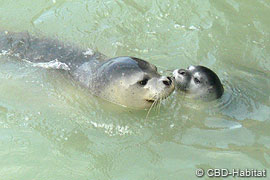 | |
The total number of detected pups born during the 2008 reproductive season was 45, reaching almost the same number as in 2007 (46 pups) [See Cabo Blanco annual pup production, 11 (2): November 2008].
In addition to the stabilization in the number of pups born, the breeding season has spread from May to November, with a maximum number of births occurring in August (11 pups) and September (13).
The discovery this year of another breeding cave leads us to believe that 2008 productivity could be underestimated, as a certain number of pups might not have been detected due to difficulties in the monitoring the cave.
22 females and 21 males were born in 2008. The sex ratio at birth was therefore even for this year. There were only two pups born that did not have their sex determined; these animals disappeared from the breeding caves, and their carcasses were not found.
The neonatal mortality rate (NMR – pups dead or disappeared / total pups) was 0.24, the minimum detected in the colony since monitoring began. This means that 24% of all pups died before reaching the age of the first moult (two months old). The mortality rate was similar for both males and females during 2008. – Miguel Angel Cedenilla, Hamdi M’Barek and Moulaye Haye, CBD-Habitat Foundation.
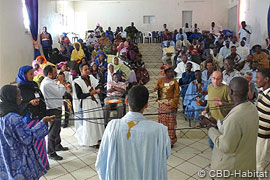 | |
Three hundred and twenty teachers from the primary and secondary schools of Nouadhibou (Mauritania) participated in both theory and practical training on environmental education, organized by CBD-Habitat during February 2009. The objective was capacity-building, helping the teachers to develop, in an effective way, environmental educational programmes, and to implement them in Nouadhibou’s schools. With this objective, an environmental information handbook was also published in French and Arabic and distributed among school teachers during the training period [available for download in French, see below]. Also, a practical nature guide was published in order to assist teachers taking visiting school groups through the Cap Blanc Satellite Reserve and its environmental information facilities [available for download in French and Arabic, see below].
During the course, both theoretical and practical skills were emphasised, with practical educational techniques focusing on learning games for students.
This educational programme formed part of the project “Qualification of different sectors of the Mauritanian population in environmental education and sustainable use of natural resources”, financed by the Spanish Cooperation Agency for Development, and the Spanish National Parks’ Network, and executed by CBD-Habitat.
It was the first course of its kind held in Mauritania. – Ana Maroto, Moulaye O.Haye and Hamdi M’Barek, CBD-Habitat Foundation.
CBD-Habitat. La Réserve Satellite du Cap Blanc [Guide to the Satellite Reserve of Cap Blanc, in French and Arabic]: 1-12. [PDF  880KB]
880KB]
CBD-Habitat. Manuel d’éducation environnementale destiné aux professeurs de l’enseignement primaire et secondaire de Mauritanie: 1-70. [PDF  8.5MB]
8.5MB]
Mediterranean News continues with Spain and Turkey...
Copyright © 2009 The Monachus Guardian. All Rights Reserved |